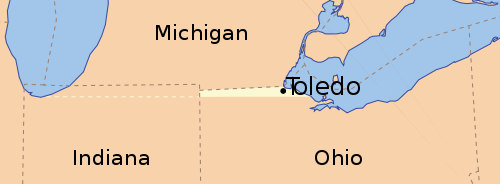Holy Toledo
Ask any college football fan about rivalries, and the long-standing friendly (okay, not so friendly) “hatred” between Michigan and Ohio State will undeniably make their list. The annual matchup, once ranked by ESPN as the top rivalry in sports, dates back to 1897 with over 100 gridiron battles since.
But Michigan and Ohio once went to war — real war, with militias and, perhaps, maybe even bayonets and horses.

Ohio became a state in 1803. Two years later, the U.S. government formed the Michigan Territory, a pre-statehood area encompassing the modern states of Michigan, Wisconsin, Minnesota, Iowa, and parts of North and South Dakota. But map-making at the time wasn’t all that great. Maps were best guesses as to the true geography and topograpy of the area, and when reality struck in late 1834 or early 1835, it turned out to be different than what the maps suggested. A nearly 500 square mile strip of land between Michigan and Ohio, dubbed the “Toledo Strip” after the major city in the area (seen above), was suddenly in dispute. Both sides wanted the land, particularly because it was increasingly clear that the location of what would later be Toledo was perfect for a port city, and therefore, an economic boon awaited the ultimate owner.
In April of 1835, President Andrew Jackson attempted to stave off the conflict. Unfortunately, he, too, was conflicted. He asked his attorney general to investigate whether Michigan’s or Ohio’s claim was, legally, correct, but quickly realized that Ohio — like now — was a “swing state” in the presidential election. He decided that it’d be best to appease Ohioans and give them the Strip, hoping to entice them to vote for the Democratic candidate in the 1836 election. But Jackson’s attorney general reported back with contrary findings, concluding that Michigan’s claim would carry the day. Jackson decided to try and pull an end-around, asking to simply re-survey the line (with the expectation that the new survey would put the Strip in Ohio). Michigan, flatly, said no.
Unable to settle the issue amicably, the two sides raised militias and entered the area, with the Michigan forces on one side of a key river in the area, and Ohio’s on the other. Thankfully, few shots were fired, and the rare exceptions were warning shots aimed at the sky. The only bloodshed in the entire months-long skirmish ocurred on July 15, 1835, when Joseph Wood, a Michigan sheriff, went into Toledo to arrest Benjamin Stickney, a Ohioan major, for trespassing on Michigan soil. One of Stickney’s sons (named Two — really) stabbed Wood with a pen knife; the wound was not fatal.
With hostilities overblown and subject to eruption, Jackson tried again to resolve the conflict. In June of 1836, he signed into law an act which would allow the Michigan territory to become a state, under the condition that it ceded any claim to the Toledo Strip to Ohio. (Michigan would get most of what is now known as the Upper Peninsula
as part of the deal, as well.) But Michigan again refused, and it seemed like an escalation of the war was likely. Ohio had authorized $300,000 to raise its militia; per the Michigan Department of Military and Veteran Affairs, Michigan one-upped Ohio by authorizing $315,000 for similar efforts.
This last action ended up causing the “war” to end — not because Michigan now had the better militia, but because it had more debt. As Michigan.gov notes, the Michigan territory was teetering on bankruptcy at the close of 1836 and, not being a state, was not eligible for “a five percent commission on the sale of federal lands” which would have netted Michigan roughly half a million dollars. WIkipedia further notes that the federal government was running a budgetary surplus at the time, and $400,000 was to be distributed to the states — and Michigan wasn’t one yet.
On December 14, 1836, Michigan accepted Jackson’s terms. In January, it became the 26th state in the Union. And a month earlier, in the presidential election? Martin Van Buren, a Democrat (like Andrew Jackson), won — but not because of Andrew Jackson’s efforts in Ohio. Ohio’s electoral delegates ended up voting for William Henry Harrison, the Whig candidate.
Bonus fact: While Martin Van Buren won the Presidency, his running mate, Richard Mentor Johnson, failed to win the Vice Presidential election outright. That year, there were 294 available votes in the Electoral College; to win, a candidate needed 148 or more. Van Buren received 170 and won the Presidency without controversy. But the 23 electors from Virginia who voted for Van Buren refused to also cast their ballots for Johnson. Johnson received only 147 votes, and fell one shy of the 148 needed. As required by the Constitution, the election then went to the U.S. Senate, which ended up electing Johnson anyway.
From the Archives: Taking a Bullet for Your Client: Another story from Ohio in the 1800s, this one involving a guy who probably shouldn’t have been using a gun.
Related: “The Toledo War: The First Michigan-Ohio Rivalry” by Don Faber. Four stars on three reviews.

Leave a comment